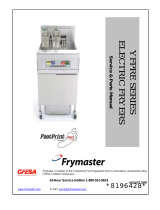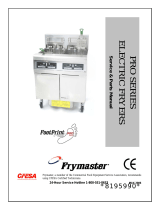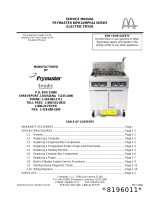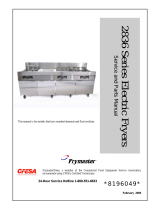
i
FILTERQUICK
™
FQG30 SERIES GAS FRYERS
SERVICE MANUAL
TABLE OF CONTENTS
CHAPTER 1: Service Procedures
1.1 Functional Description ............................................................................................................................................................ 1-1
1.2 The Electronic Ignition System ............................................................................................................................................. 1-1
1.3 Interface Board .......................................................................................................................................................................... 1-2
1.4 Thermostats ................................................................................................................................................................................ 1-4
1.5 Accessing Fryers for Servicing .............................................................................................................................................. 1-4
1.6 Cleaning the Gas Valve Vent Tube ...................................................................................................................................... 1-4
1.7 Checking the Burner Manifold Gas Pressure ................................................................................................................... 1-5
1.8 Measuring Flame Current ...................................................................................................................................................... 1-6
1.9 Replacing Fryer Components ............................................................................................................................................... 1-6
1.9.1 Replacing the Controller or the Controller Wiring Harness .................................................................. 1-6
1.9.2 Replacing the Temperature Probe or High-Limit Thermostat ............................................................. 1-7
1.9.3 Replacing the Interface Board ......................................................................................................................... 1-7
1.9.4 Replacing an Ignition Module ......................................................................................................................... 1-8
1.9.5 Replacing an Ignitor Assembly ....................................................................................................................... 1-8
1.9.6 Replacing or Cleaning a Combustion Air Blower ...................................................................................... 1-8
1.9.7 Adjusting the Air/Gas Mixture ...................................................................................................................... 1-10
1.9.8 Replacing a Gas Valve ..................................................................................................................................... 1-10
1.9.9 Replacing a Burner Assembly ....................................................................................................................... 1-11
1.9.10 Replacing the Filter Motor, Filter Pump, or Filter Pump ...................................................................... 1-12
1.9.11 Replacing the Frypot ....................................................................................................................................... 1-12
1.9.12 Replacing Frypot Insulation and/or Upper Burner Rails ...................................................................... 1-13
1.10 Troubleshooting and Problem Isolation ............................................................................................................................ 1-16
1.10.1 Heating (Ignition) Failure ............................................................................................................................... 1-16
1.10.2 Improper Burner Function ............................................................................................................................. 1-17
1.10.3 Improper Temperature Control ................................................................................................................... 1-18
1.10.4 Controller Malfunctions ................................................................................................................................. 1-19
1.10.5 Filtration Malfunctions ................................................................................................................................... 1-19
1.10.6 Leakage ................................................................................................................................................................ 1-20
1.11 Troubleshooting Guides ...................................................................................................
................................................... 1-20
1.11.1 Troubleshooting the 24 VAC Circuit .......................................................................................................... 1-20
1.11.2 Troubleshooting the Gas Valve ................................................................................................................... 1-22
1.11.3 Troubleshooting the Temperature Probe ................................................................................................ 1-23
1.11.4 Replacing the Transformer or Filter Relay ................................................................................................ 1-23
1.12 Basket Lift Service Procedures ........................................................................................................................................... 1-24
1.13 Probe Resistance Chart ........................................................................................................................................................ 1-26
1.14 ATO (Automatic Top-Off ) Service Procedures ............................................................................................................. 1-26
1.14.1 ATO (Automatic Top-Off Troubleshooting) ............................................................................................. 1-26
1.14.2 ATO (Automatic Top-Off Troubleshooting) Board Pins and Positions ........................................... 1-28
1.14.3 Replacing the ATO Board or Transformer ................................................................................................ 1-29
1.14.4 Replacing the ATO Pump or Solenoid ....................................................................................................... 1-29
1.15 MIB (Manual Interface Board) Service Procedures ...................................................................................................... 1-29
1.15.1 Manually Draining, Refilling or Filtering Using the MIB Board .......................................................... 1-30
1.15.2 MIB (Manual Interface Board) Troubleshooting ..................................................................................... 1-31
1.15.3 MIB (Manual Interface Board) Pin Positions and Harnesses ............................................................... 1-33
1.15.4 MIB (Manual Interface Board) Display Characters ................................................................................. 1-34
1.15.5 Replacing the MIB Board ................................................................................................................................ 1-34
1.15.6 Control Power Reset Switch .......................................................................................................................... 1-35
1.16 Bulk Oil Service Issues ........................................................................................................................................................... 1-35
1.16.1 Bulk MIB Tests .................................................................................................................................................... 1-35
1.16.2 Bulk Wiring .......................................................................................................................................................... 1-36
1.16.3 Bulk Oil Plumbing Schematic ....................................................................................................................... 1-37
1.16.4 Bulk Oil Test Quick Reference ....................................................................................................................... 1-37
1.17 AIF (Automatic Intermittent Filtration) Service Procedures .................................................................................... 1-39
1.17.1 AIF (Automatic Intermittent Filtration) Troubleshooting ................................................................... 1-39
1.17.2 AIF (Automatic Intermittent Filtration) Actuator Board Pin Positions ............................................ 1-41
























